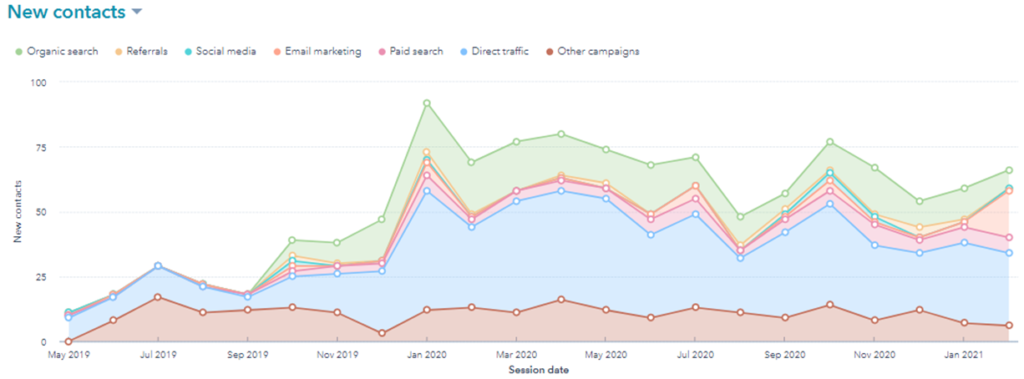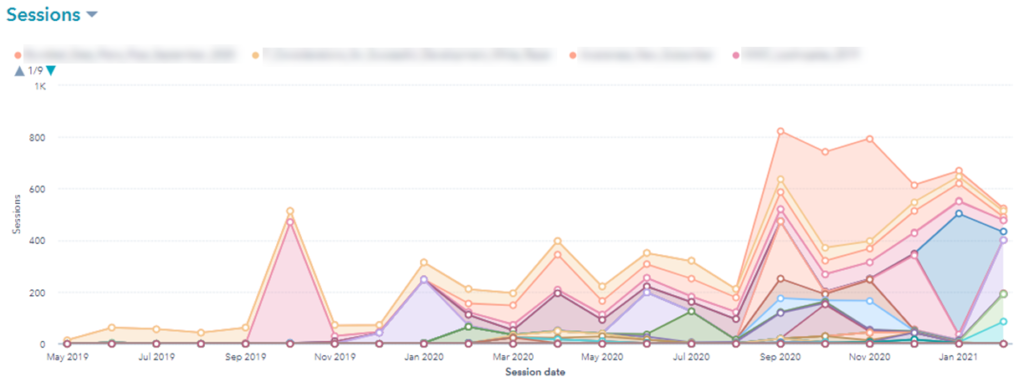

Our first step was to establish KPIs to be included on their weekly Traction/EOS scorecard. With a strong SEO foundation from our previous work, we decided to focus first on Inbound marketing and leveraging the Hubspot platform that they already had in place. The company-level KPIs we defined were:
Using these metrics, we could determine how much our efforts were leading to site traffic (excluding Google Ads traffic which can be “purchased”), how often and effectively we are interacting with our database of contacts, and how well that traffic is converting on the site.
Step two was to establish the necessary systems and analytics that were needed to effectively use the tools and gather KPI data. The company used ZOHO for their CRM and with a rich history of effectively using that tool, we elected NOT to bring the Sales team into Hubspot. Preserving the historical data in Zoho was considered crucial for obtaining their eventual exit (which they DID accomplish…later in the case study). An integration was established between Zoho and Hubspot and the old website forms were replaced with Hubspot forms. Google Analytics was already setup very well, but we established new filters and views to be used for our reporting. Custom dashboards were built in Hubspot.
Our next step was to take previously defined Personas and perform a content audit. We matrixed the existing library of content against personas and buyer’s journey in an effort to understand where, how and with whom to use each individual piece of content. We also identified gaps, by persona and buyer’s journey, that could be filled with new content. This allowed us to create a content blueprint for new content creation. We also established Lead Scoring within Hubspot and brought thousands of good “opt-in” contacts from Zoho into Hubspot for marketing automation.
In cooperation with Nimbelink, we then began to build out workflows and automation. We created a content blueprint and an engagement calendar. All of our KPIs were beginning to lift.
Then COVID-19 hit. As tradeshow after show cancelled, suddenly their historical, primary marketing effort was eliminated. The good news is that we were ALREADY doing all of things we needed to be doing to maintain a strong online marketing presence. We did not need to pivot our marketing, as the pivot had already taken place. We simply needed to continue the course, seeking every conceivable opportunity to add value to our buyer personas, including a webinar series, virtual tradeshows and other learning events.
The results were dramatic! The number of influenced contacts rose nearly 5000%, and sessions driven by marketing activities was up by 1,500%. The number of new contacts was up by over 500%, in the midst of a pandemic with no tradeshows to attend. And this is not a product that benefitted from a pandemic.
The only frustrating part of this case study is our inability to compare results to a benchmark. How much would the company have grown if we implemented Inbound Marketing without a pandemic? How much would the company have grown if we were still able to compliment this new initiative with their traditional marketing activities? It is impossible to know the answers to these questions, but the success we enjoyed played a role in allowing the business to engage in M&A and obtain a successful exit to a complimentary business, still in a pandemic.
We are grateful to have been given the opportunity to engage with NimbeLink multiple times along their journey. We can state with certainty that our original SEO efforts, combined with the Inbound Marketing that was put into place in 2020 played a role in their success.
% Increase in Influenced Contacts
% Increase in Website Sessions Driven by Marketing Activities
% Increase in New Contacts
% Increase in Qualified Leads YOY



Let us help you grow your business through inbound marketing – let’s connect over coffee or cocktails!